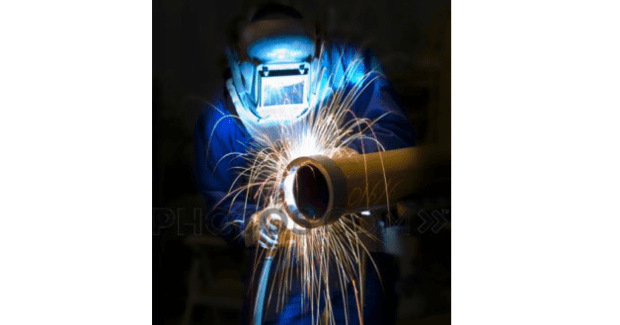What to Know About Stress Relieving After Welding
With the proper process, oil and gas industries that require components to maintain corrosion or cracking resistance can have peace of mind that elevated service temperatures or multiple repair cycles won’t cause damage.
Posted: July 24, 2020
MELTING POINT COLUMN
BY DERICK RAILLING
For critical applications, particularly those found in oil- and gas-related industries, stress relieving can be an essential part of safeguarding the integrity of finished welds.
Stress relieving involves heating the weld and base material for a specific length of time at a recommended temperature schedule. Heating can be accomplished using a furnace, resistive heating equipment, or induction heating equipment. The temperature threshold must be below the lower transformation temperature of the weld — or the point at which changes to the microstructure occur — to prevent damage. After holding the temperature for the required time, the heat is slowly ramped down in increments to allow even cooling.
The process tends to be used for low-alloy steels and applications with thick and highly restrained joints that contribute additional residual stresses based on their design.
The complexity and cost of stress relieving can vary depending on whether an entire part needs to be stress relieved (and the size of the part) or whether the process can be localized at the weldment.
What Are The Benefits And Potential Pitfalls?
The time/temperature schedule during stress relieving will vary according to the application, material, and filler metal being used. But when completed properly, stress relieving offers key benefits including:
- Reducing residual stress in the weld and heat-affected zone (HAZ)
- Improving corrosion resistance
- Minimizing the risk of caustic weld cracking
- Improving dimensional stability
- Improving the service life of a weldment.
It’s critical to follow the exact procedures for stress relieving. Bringing a part up to temperature too fast, holding it too long or at too-high temperature, or cooling it too quickly can all be detrimental to the material’s microstructure. If the microstructure is altered, it can lead to potential failures.
Filler Metals For Stress Relieving
Some filler metals are specially formulated for use with stress relieving. Typically, they are required to have classification testing performed in the stress-relieved condition. Refer to the applicable American Welding Society (AWS) filler metal specifications for information on required stress-relieving schedules.
If stress relieving is deemed beneficial or required, never use a filler metal that isn’t designed or intended for stress relieving (for example, one formulated for the as-welded condition). The heat introduced by the process can lower the weld’s tensile strength, so a weld made with an as-welded filler metal could be weaker than required. It could also affect the weld’s toughness. The weld may fail unexpectedly, which can lead to dangerous consequences in an oil and gas application.
Note that certain manufacturers may test the use of stress relieving with filler metals that are not required to use the process and will report the results for informational purposes only.
It’s also important to always stress relieve a weld made with a filler metal formulated for this process. Doing so restores ductility and reduces weld tensile strength to within the intended range for service. A ductile weld that isn’t overmatched to base metal strength helps reduce the risk of residual stresses leading to weld or base metal cracking.
Filler metals for stress relieving are available in stick electrodes, solid wires, metal-cored wires, and gas-shielded flux-cored wires. Submerged arc welding flux and electrodes are also an option.
AWS defines the stress-relieving hold time for testing of the following filler metal suffixes and temperatures at one hour unless otherwise specified. That means the filler metal has to maintain its mechanical properties at the given temperature for one hour to receive the specific designation. Some examples are:
- Per 5/A5.5M:2014 Specification for Low-Alloy Electrodes for Shielded- Metal Arc Welding
- E8018-C1, E8018-C2: 1,125° F
- E8018-D1, E10018-D2, E8018-D3: 1,150° F
- Per A5.28/A5.28M:2005 Specification for Low-Alloy Steel Electrodes for Gas-Shielded Arc Welding
- ER80S-B2, E80C-B2: 1,150° F
- ER90S-B3, E90C-B3: 1,275° F
- Per29/A5.29M:2010 Specification for Low-Alloy Steel Electrodes for Flux-Cored Arc Welding
- E8XT1-A1C, -A1M: 1,150° F
- E8XT5-Ni1C, -Ni1M: 1,150° F
- Per 23/A5.23M:2011 Specification for Low-Alloy Steel Electrodes and Fluxes for Submerged Arc Welding
- A1, A2, A3, A4, B1, B5, Ni1, Ni2, Ni3, F1, F2: 1,150° F, B6, B6H, B8: 1,375° F
These are just a few specific examples. For a comprehensive list of products tested for stress-relieved properties, review the appropriate AWS filler metal specification.
Also, many real-world applications may require different temperatures, mechanical properties, or longer stress-relieving times. If that’s the case, it’s best to contact a trusted filler metal manufacturer to determine which product meets those needs. The manufacturer may be able to provide supporting documentation to assist with design or engineering approval.
Concluding Thoughts
Removing residual stresses from critical welding applications is key. With a proper stress-relieving process, oil and gas industries that require components to maintain corrosion or cracking resistance can have peace of mind that elevated service temperatures or multiple repair cycles won’t cause damage.
As with any aspect of the welding operation, however, welding operators must follow and implement every step of the stress-relieving process carefully. Consulting filler metal spec sheets, as well as the welding procedure, are both important ways to ensure success.
Subscribe to learn the latest in manufacturing.













